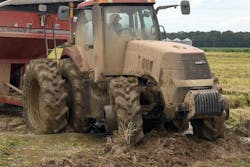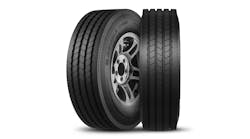Modern Tire Dealer has partnered with AG Tire Talk to provide answers to insightful questions that farm tire dealers have about farm tire technology. This is the next installment in our ongoing series, which is designed to help farm tire dealers better connect with their customers. A trending question, followed by answers, will appear in our Commercial Tire Dealer section every other month. For complete answers, click on www.agtiretalk.com. AG Tire Talk podcasts can be found here.
Question: Why is it important for ag tires to have a small slip percentage and what is the recommended percentage of slip for mechanical front-wheel drive (MFWD) and four-wheel drive (4WD) tractors?
DAVE PAULK, manager, field technical services, BKT USA: MFWD tractors are 4WD tractors that can be locked in or out of four-wheel drive. They have different-sized drive tires on the front and rear and are geared to run at approximately the same revolutions. 4WD tractors are full-time four-wheel drive. They are geared the same front to rear and run the same-size tires on front and rear.
Ballast, air pressure and tire slip go hand-in-hand when setting up a tractor. Ballast and air pressure should be used to achieve just enough traction to transmit power to the ground without excessive tire slip. Industry standards of 5% to 15% are the suggested range for tire slip. Industry standards suggest the ideal range is 8% to 12% for the least compaction, best traction and fuel efficiency. If this is exceeded either way, it costs power from the tractor, as well as fuel efficiency.
Having too much ballast and not enough air pressure can cause reduced tire slip under 5%. Too much ballast anchors tires to the soil and allows too little tire slip. While this may sound like a good thing, it can cause tires to slip on wheels, can cause lug cracking at the base of the lugs and can cause drivetrain problems.
When tires slip on the wheel, the rubber from the tire bead fills up the knurling in the wheel and will destroy the tire bead. Lug cracking at the base of the lug causes lugs to tear off because of the increased torque on the tire. Drivetrain problems can occur because there is too much stress on the axles and transmission. The slip provides a safety valve against shock overloads and reduces wear on the drivetrain. In sum, all of the above increases soil compassion and reduces the efficiency of the tractor. Power and fuel are wasted in trying to move the tractor through the soil. If slippage is less than 5%, weights need to be removed and air pressures adjusted.
Having not enough ballast and too much air pressure can cause excessive tire slip above the 15% mark. The tires turn faster than the ground speed of the tractor. Too much slippage results in tire spin and energy loss to the ground. Less than 60% to 70% of the power produced is used to pull implements through the soil. This can drop to 50% in sandy soil. This causes the tire to wear out prematurely and can cause lug cracking because of spinning. You are limited to the weight of the implements that can be pulled or carried. This adds to the fuel and labor cost.
If slippage is above the 15% mark, more weight may need to be added to the tractor and air pressures may need to be adjusted. Duals with reduced air pressure levels can help. If the tires are heavily worn, new tires may be needed for traction.
DANA BERGER, ag business development manager, Continental Commercial Specialty Tires: Depending on how it’s used, the word “slip” is often synonymous with less than desirable outcomes. To slip is to fall, skid or misstep. Therefore, you can conclude that a tractor tire slip is usually not a good thing. Each percent of slip translates into lost energy, which translates into increased demand on fuel. Burning additional fuel means raising your operating costs. Add the growing fuel expense to another known fact that slippage harms the structure of soil and you will starting to see a vicious cycle leading to lost profit levels. Lost profit will have you calculating all of the ways to reduce slip.
Reducing your slip percentage might be the “heads up” approach because you are attempting to combat the program before it occurs. But slip is required to generate traction. Even in the best conditions on a dry concrete surface, car tires require certain low slip rates to transmit acceleration and braking forces, as well as steering,
Making a general statement for optimal traction and slip rates on soil isn’t easy. Soil has a very wide range of surface types - dry sand without any structure; hard, dry soils with some loose material; a variety of wet and even muddy forms; and more.
The looser the structure of the soil, the more slip that’s required to generate high-traction forces. The more lugs on the ground, the less slip will be required to generate the same traction.
In very difficult weather conditions, slip rates can climb to 40% or even more, but this is tolerable for only small or short passages of a total field. When working on dry soils, values of 10% to 15% are ideal. In wet conditions, up to 20% can be acceptable for higher-torque applications, like plowing.
More ballast, up to a certain value, is helpful to reduce slip in high-torque applications. It compresses loose material and generates a solid compacted base behind each lug. In combination with slip and the friction coefficient, more ballast means a higher maximum force/torque that’s able to be transmitted. Even here there are challenges. Too much ballast and energy consumption increases to carry the additional load provided by the ballast. Therefore, the risk of soil compaction increases because more load means deeper track depth in wet soil.
Arguments can be made for tires having a slower slip rate - if you factor in a lower inflation pressure, allowing tires to lower an extra few lugs to the surface in order to grip and if the soil under a slightly slippery surface is dry.
GREG GILLAND, vice president, global agriculture, Maxam Tire North America: As with all challenges in the ag industry, every operation is a compromise between the equipment, the crop, the implement and operational requirements to complete the job. In farming operations using a two-wheel drive (2WD), MFWD or 4WD tractor, it is not recommended to use 100% of the rated axle power to pull your implement. If a farmer uses 100% of his machine’s power to pull an implement or load below five mph, he runs the risk of over-straining the engine and drivetrain systems, causing premature wear of those components. This also will affect tire life, as well as possibly increasing soil compaction due to the additional strain.
The goal is to achieve the optimal transmission of power to each axle, allowing for a percentage of tire slip to achieve the highest level of power and traction based on the load carried or pulled, road or field usage and the required working speed to get the job done. Tire or wheel slippage is a calculation that the tractor’s drive system measures by assessing the number of revolutions based on tire circumference, power, time and the actual distance traveled. In essence, if you travel 200 feet and your actual tire revolution distance traveled is equal to 220 feet traveled, your wheel/tire slip rate will be 10%.
The key always remains in understanding the right load equation for your customer’s tires and the appropriate pressure to carry that load. The right tire - set at the right air pressure, with the right footprint - will deliver the optimal traction required and reduce ground compaction impact.
DAVID GRADEN, operational market manager, agriculture, Michelin North America Inc.: Desired slip percentages really depend on what the operator wants to achieve. Similarly, the type of tire fitted on the machine and air pressures ultimately affect target slip.
Regardless of tire chosen, if an operator wants to maximize both fuel economy and machine efficiency, he should target a slip rate of approximately 12%. At this rate, the operator is not using excess fuel to get the job done, while at the same time maximizing tractive efficiency. This is a calculated balance. If an operator wants to maximize machine efficiency and is not as concerned about fuel costs, then I would recommend a slip rate between 7% and 9%. This is most common when fuel costs are low. At this rate, tractive capacity is at its best, without creating power hop - assuming the machine’s weight distribution is optimized.
BLAINE COX, national product manager - agriculture, golf and turf, Yokohama Off-Highway Tires America Inc.: Slip is important in optimizing tractor efficiency and protecting tractor drivetrain from strain and damage. Too much tire slip is inefficient. You’re spinning out and burning fuel on wheel movement that isn’t pushing the customer’s tractor forward.
Too little slip is a problem, too. If your customer doesn’t experience a little slip, he is being inefficient in other ways. Tires slip until the have accumulated enough resistance to push against so they can move a tractor forward and pull a load behind it, whether it’s a buggy full of grain or a field cultivator. If tires are encountering zero slip, it means they are in constant contact with all the resistance it takes to do the work. That’s an indication that the tractor is either too heavily ballasted or that tires are buried so deep in the soil that they are having to constantly dig themselves out - burning energy trying to overcome rolling resistance instead of just doing the necessary work of moving the tractor. It also means they are causing excessive soil compaction.
The other program with zero slip is that the tractor’s drivetrain is under constant strain. Equipment manufacturers count on a little wheel slip as a way to absorb some of the energy that would otherwise wear on transmissions, much as tires absorb some of the impact that would otherwise rattle equipment.
Optimal slip is slippery. Like most things in farming, it depends on the soil, the conditions and the machine. Optimal slip can range from 8% to 10% in firm soil, where we would expect to feel less slip because tires can encounter needed resistance more quickly - as high as 18% to 20% in loose soil. Two-wheel drive tractors tend to run optimally with a little more slip than 4WD tractors do, but the differences are pretty subtle. While a 4WD tractor’s optimal range may be around 8% to 10% in average loam, a 2WD tractor would be most efficient between 10% to 5% slip in the same field. The bottom line is to embrace some slip.

